Key Facts:
- Florida is home to 46 native snake species and only six of them are venomous.
- St. John’s River, which is Florida’s largest river, is home to eastern indigo snakes, cottonmouths, coral snakes, and rattlesnakes.
- Lake Iaomonia is especially snake infested with banded water snakes, cottonmouths, Florida green water snakes, eastern kingsnakes, red-bellied snakes, southern ribbon snakes, ringneck snakes, and scarlet snakes.
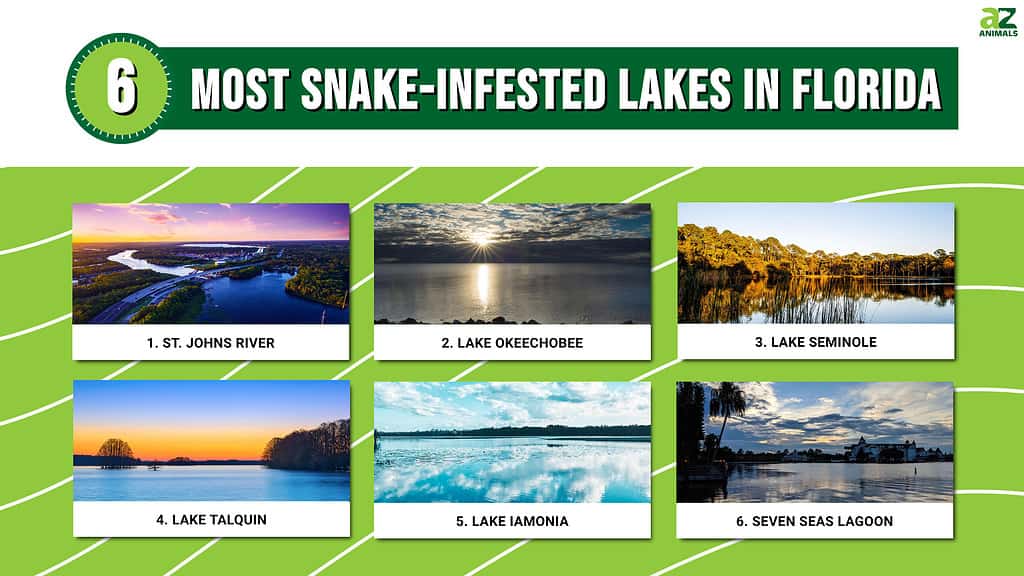
Florida undoubtedly has one of the most diverse ecosystems in the world. The United States Department of Agriculture states that the state is home to 4,368 known animal species and 3,038 plant species. It also ranks among the top five states in endemic species with 269 species of animals found in the state not present anywhere else.
One of Florida’s most commonly-sighted animals is the snake. The state houses 46 native snake species, eight of which are harmless water snakes. Although snakes are commonplace in all Florida lakes, some are more heavily populated with these slithering reptiles than others. Let’s take a look at six Florida lakes (and rivers) with large snake populations.
1. St. Johns River

St. Johns River, the largest river in Florida, is home to Florida rattlesnakes, Florida coral snakes, blue indigo snakes, and cottonmouths.
©Javier Cruz Acosta/Shutterstock.com
St. Johns River is the largest river entirely within the state of Florida. Not only does the 310-mile river flow through 12 counties, but it is also extremely significant for commercial and recreational purposes. Unlike most other rivers, St. Johns never seems to be in a hurry and flows at a speed of 0.3 mph (0.13 m/s), making it perfect for turtles, alligators, and of course, snakes.
Some of the most popular species found in and near the river are rattlesnakes, eastern coral snakes, eastern indigo snakes, and cottonmouths. St. Johns is also a popular spot for fishing and bird-watching and is known as the “Bass Fishing Capitol of the World.” Not shockingly, the largest bass ever caught in the state was fished from the Ocklawaha River, which flows into St. Johns.
2. Lake Okeechobee

Lake Okeechobee is home to pythons, Brahminy blind snakes, and Florida sugar king snakes.
©Allison Michael/Shutterstock.com
Lake Okeechobee, which stretches 730 miles, is the largest freshwater lake in Florida and the 10th largest in the USA. But despite its amazing length, the lake isn’t nearly as deep as others its size, with an average depth of only 9 feet. In comparison, Florida’s largest reservoir, Lake George, measures 11 miles long and has a similar average depth of 8 feet, despite being less than 1/60 of Lake Okeechobee’s length. However, this shallow depth makes the river perfect for snakes.
Some of the most common species spotted in and around the lake include Florida green watersnakes, brown watersnakes, and the eastern kingsnake. These snakes feed on fish, rodents, and other reptiles in the area. Some of the most common fish species spotted in Lake Okeechobee are crappies, largemouth bass, and bluegills.
3. Lake Seminole
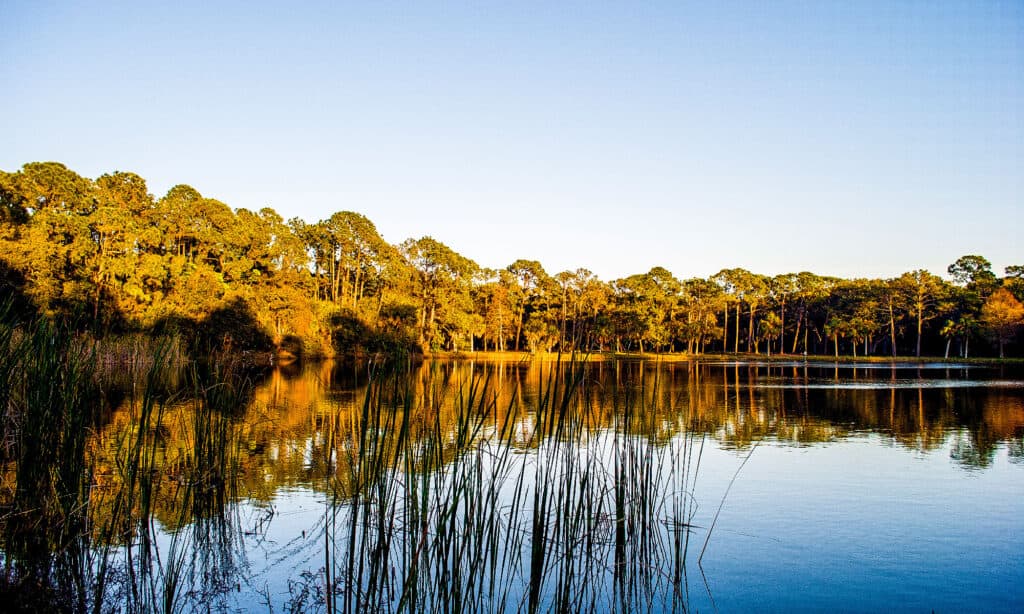
Lake Seminole is home to cottonmouths, pythons, and rattlesnakes of various species.
©Jeremy A. Casado/Shutterstock.com
Although Lake Seminole has only its borders within Florida and the rest of its body in the state of Georgia, it is still considered s a Florida lake. This man-made lake was completed in 1952 and was named after the Seminole Indians, the native Americans who initially occupied the area. The reservoir stretches 35 miles and has an average depth of 10 feet but runs as deep as 30 feet in some areas.
Lake Seminole is known to host a variety of wildlife, such as alligators and fish, and is quite a popular spot for goose-hunting. The lake is also home to an array of snakes, including cottonmouths, pythons, and even rattlesnakes of various species. Residents around these areas often spot snakes in nearby creeks, fields, and even in their backyards.
4. Lake Talquin
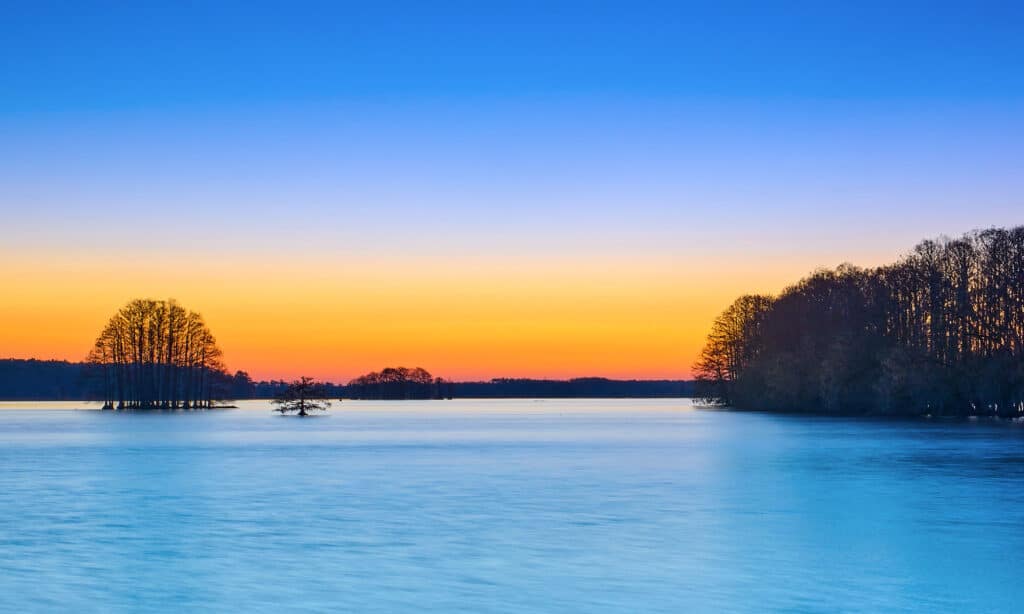
Lake Talquin is located on Florida’s Ochlockonee River and is home to cottonmouths, red-bellied watersnakes, and brown water snakes.
©iStock.com/Patrick Jennings
Lake Talquin is a man-made reservoir located on Florida’s Ochlockonee River. Although the lake was initially created to generate hydroelectric power, this didn’t stop several species of snakes from making their home in it. Some of the most commonly-spotted snake species in Lake Talquin are cottonmouths, red-bellied watersnakes, and brown water snakes.
Despite its large population of snakes, the lake is much more popular for its plethora of birds. According to the Florida State Parks, Lake Talquinn is home to more than 100 bird species. The lake is also known for fishing and hosts a plethora of fish species, such as the largemouth bass, redear sunfish, bluegills, and black crappies.
5. Lake Iamonia
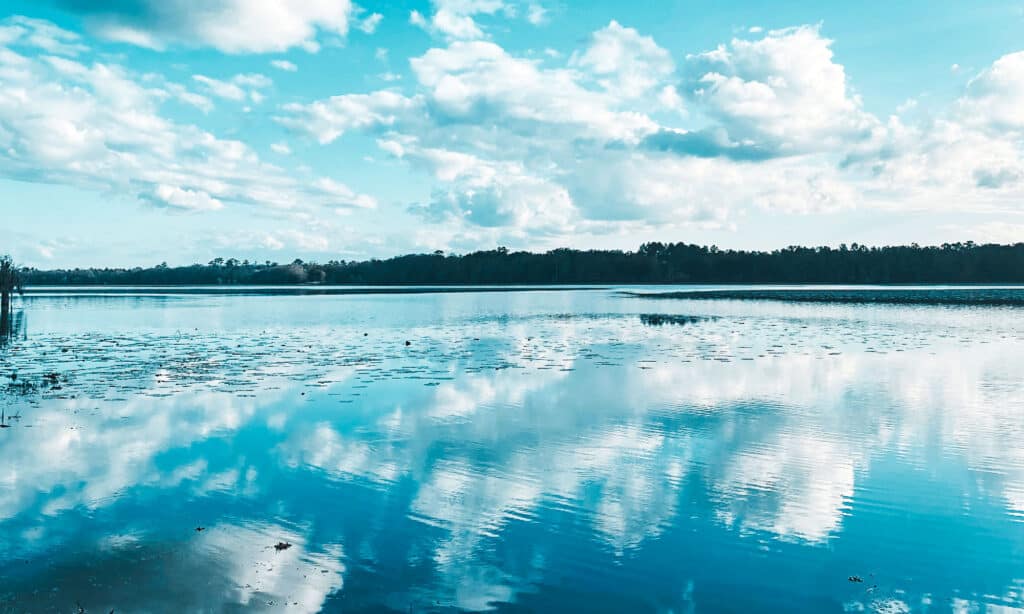
Lake Iamonia has eastern kingsnakes, corn snakes, red-bellied snakes, southern ribbon snakes, ringneck snakes, and scarlet snakes.
©Sharon T Long/Shutterstock.com
Located in Florida’s Leon County, Lake Iamonia is a seven-mile subtropical prairie lake known for its many snake species. Some of the most common species found in and around the lake are banded water snakes, Florida green water snakes, cottonmouths, eastern kingsnakes, corn snakes, red-bellied snakes, southern ribbon snakes, ringneck snakes, and scarlet snakes.
There have also been sightings of black swamp snakes, gray rat snakes, and mud snakes. However, Lake Iamonia isn’t known for only snakes. More than 15 distinct mammal species, such as coyotes, common rats, oldfield mice, foxes, and squirrels, live in the areas that surround the lake. Lake Iamonia is also a fishing hotspot.
6. Seven Seas Lagoon

The Seven Seas Lagoon is home to cottonmouths, black rat snakes, indigo snakes, and venomous rattlesnakes.
©P. Dorman/Shutterstock.com
The Seven Seas Lagoon in Bay Lake is one of the most popular water bodies in Florida, probably because it is located in the Walt Disney World Resort. Despite how popular it is, anyone who’s visited the resort will tell you just how frequently snakes are sighted in the area, and the man-made lagoon is no exception.
Some of the most common species in the lake are cottonmouths, black rat snakes, indigo snakes, and venomous rattlesnakes. This is the major reason that there have been several reports of snake bites in Disney World, with a couple resulting in the death and paralysis of the victims. Consequently, remember to keep your eyes peeled for snakes if you decide to go on a Disney vacation.
Summary of the Most Snake-Infested Lakes in Florida
Here’s a recap of the most snake-infested lakes in the state of Florida that we took a close look at:
| Number | Lake | Commonly Seen Snakes |
|---|---|---|
| 1 | St. Johns River | Rattlesnakes, eastern coral snakes, eastern indigo snakes, cottonmouths |
| 2 | Lake Okeechobee | Banded water snakes, Florida green water snakes, cottonmouths, Eastern kingsnakes, corn snakes, red-bellied snakes, southern ribbon snakes, ringneck snakes, scarlet snakes |
| 3 | Lake Seminole | Cottonmouths, pythons, rattlesnakes |
| 4 | Lake Talquin | Cottonmouths, red-bellied watersnakes, brown water snakes |
| 5 | Lake Iamonia | Banded water snakes, Florida green water snakes, cottonmouths, eastern kingsnakes, corn snakes, red-bellied snakes, southern ribbon snakes, ringneck snakes, scarlet snakes |
| 6 | Seven Seas Lagoon | Cottonmouths, black rat snakes, indigo snakes, rattlesnakes |
Staying Safe When Visiting a Snake-Infested Area
If you live in the state of Florida, it’s best to assume that there are snakes everywhere. This way, you can stay safe and protected at all times, even if there is no danger. Unless you’re looking for snakes, you should stay off bushy areas without pedestrian paths.
Snakes are pretty smart creatures and usually stay away from paths frequented by humans. However, if you do spot a snake, back away slowly and do not attempt to do anything. Once you’re safely away from it, contact the local authorities and let them know where you saw the snake. This way, you not only keep yourself safe but also prevent the snake from harming someone else.
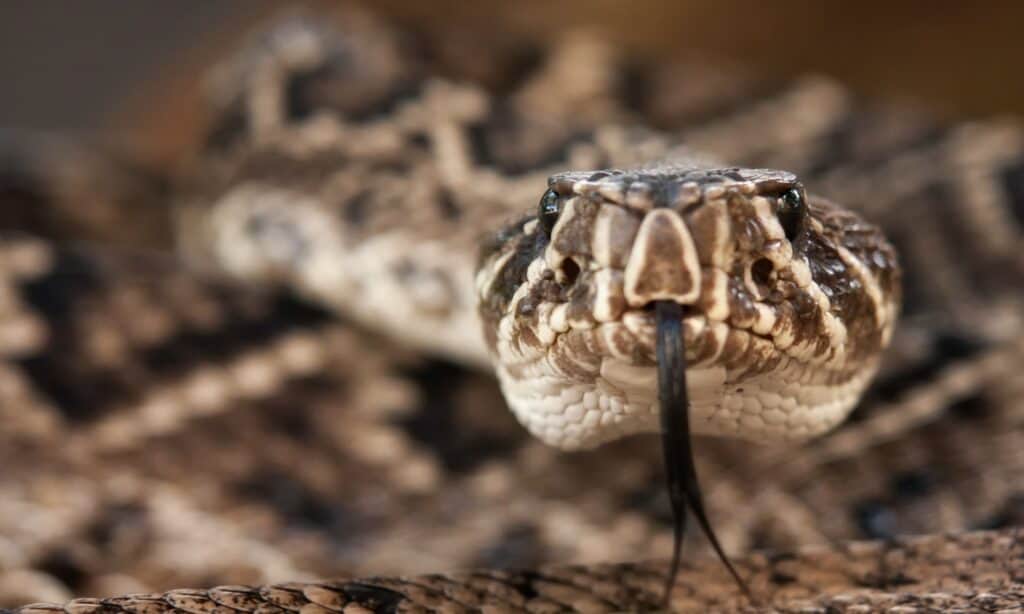
Eastern diamond-backed rattlesnakes are found in every county of Florida.
©iStock.com/Wide-River-Rick
Dangerous Animals That Live Around Lakes in Florida
If visiting one of these lakes in Florida, you have more than snakes to worry about. These beautiful water sources draw other threatening creatures that you will want to avoid. The most formidable threat is the American alligator which lurks in the brackish swamps, ponds, canals, and lakes of Florida. They are most active at dusk and dawn because that is when they are searching for food. Alligators pose a huge threat to humans, so it is important to stay vigilant and avoid their territory. Other dangerous creatures around the lakes of Florida include spiders; brown recluses and black widows that give poisonous bites. Stinging caterpillars have poisonous spines connected to them that can cause humans itching and burning sensations and even more severe reactions in some. And, finally, ticks can be found along Florida’s lakes. The black-legged tick is a carrier of Lyme disease, so it is always recommended to check your body for ticks after a day of enjoying the beautiful lakes of Florida.
The photo featured at the top of this post is © iStock.com/David_Camarillo
Discover the "Monster" Snake 5X Bigger than an Anaconda
Every day A-Z Animals sends out some of the most incredible facts in the world from our free newsletter. Want to discover the 10 most beautiful snakes in the world, a "snake island" where you're never more than 3 feet from danger, or a "monster" snake 5X larger than an anaconda? Then sign up right now and you'll start receiving our daily newsletter absolutely free.
Sources
- Forest Service, Available here: https://www.fs.usda.gov/detail/florida/learning/nature-science/?cid=STELPRDB5274354
- Seminole County Ag, Available here: https://site.extension.uga.edu/seminoleag/2022/04/snakes-of-seminole-county/
Thank you for reading! Have some feedback for us? Contact the AZ Animals editorial team.






